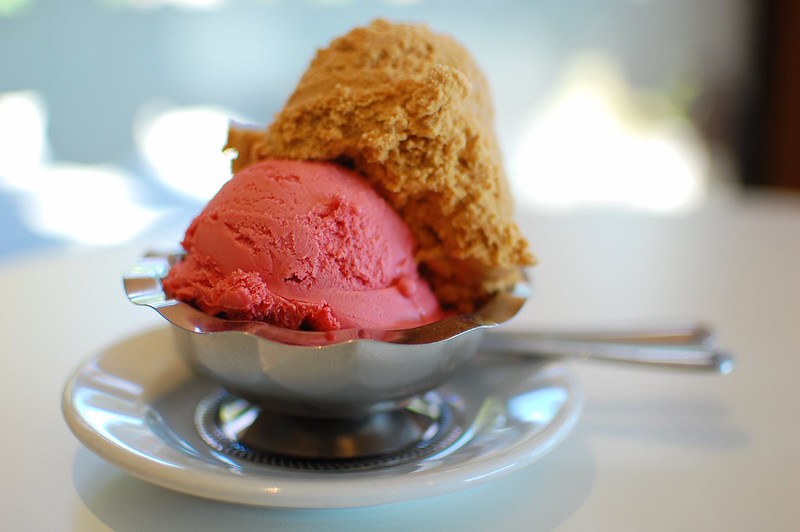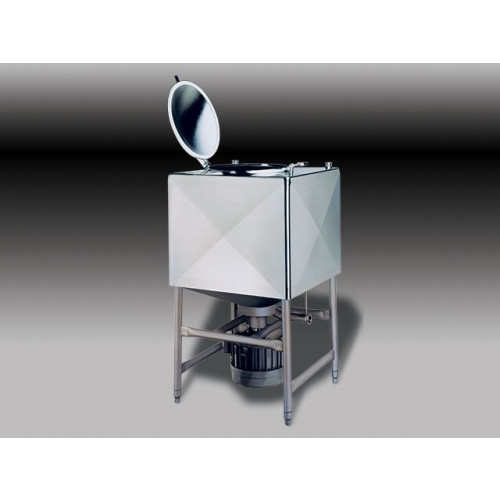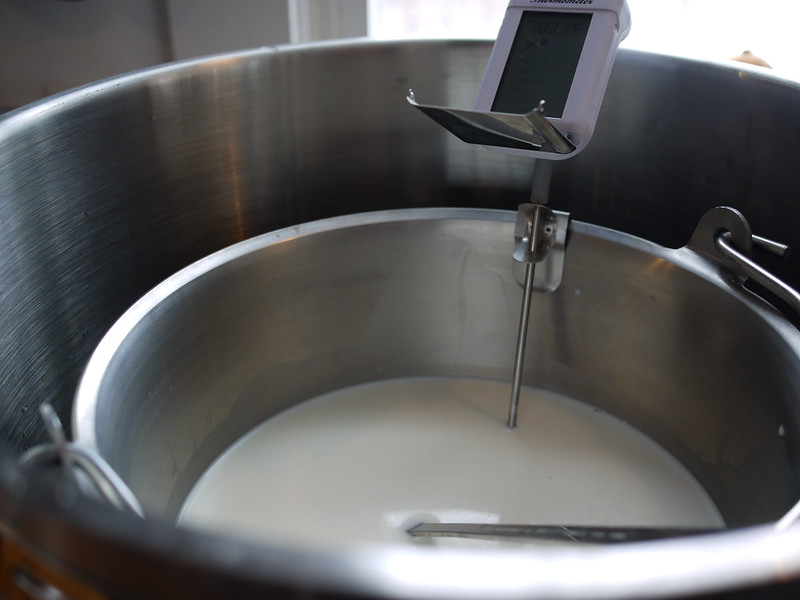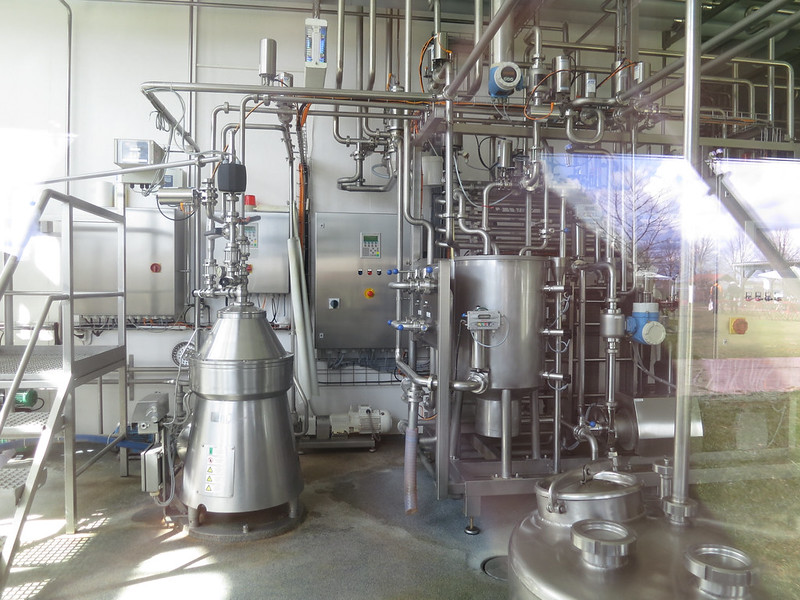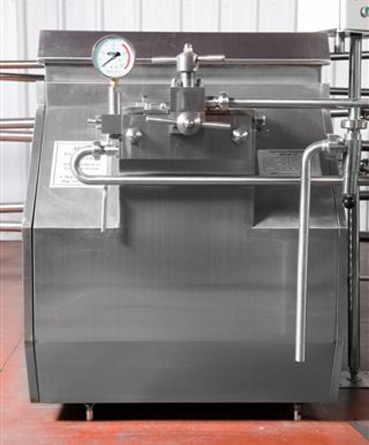Ice cream, a frozen dairy dessert, was developed in Europe and originated from the process of freezing water with salt and ice in the 1500s. Over the centuries, the manufacturing of ice cream has modernized into automated, high-volume operations that supply a wide variety of ice creams. Within the frozen dairy dessert category, ice cream is the most consumed product and has 3 main variations: Regular ice cream, higher-fat premium, and low fat/sugar-free versions.
Ingredient Preparation
Ice cream is made of milk fat, milk solids (proteins, lactose, and minerals), sweeteners, stabilizers, emulsifiers, water, and flavorings. The specific ratios of the ingredients can vary widely, with the milk fat content generally between 1% and 20% by mass depending on the desired final texture. Milk fat and solids are easily separated from the liquid milk because they are a different density than the liquid. When settled, they will separate naturally.
Sweeteners, such as sugar (sucrose) and corn syrups, are used to provide the characteristic sweetness of ice cream. Sweeteners also lower the freezing point of the mix to allow some water to remain unfrozen, yielding a smooth ice cream product that is easy to scoop and eat.
Stabilizers are proteins or carbohydrates used to increase the viscosity of the ingredient mixture and prevent the formation of ice crystals, which cause ice cream to become coarse, icy, and unpleasant to eat. Common stabilizers used in the production of ice cream include alginates such as carrageenan, gums such as locust bean or guar, and gelatins.
Emulsifiers are used to help keep the milk fat evenly dispersed in the ice cream during freezing and storage. A good distribution of fat stabilizes the air incorporated into the ice cream and provides a smooth, uniform milk product. Emulsifiers used in ice cream include egg yolks, monoglycerides, and diglycerides.
Ice cream flavorings include natural and artificial flavors, fruits, nuts, and bulky inclusions such as chocolate chunks and candies. Flavors are available in liquid, syrup, semi-solid, or solid forms and often contain additional sweeteners.
Production/Preservation
The production of ice cream consists of combining the ingredients into a homogeneous solution that is then pasteurized, homogenized, cooled, aged, flavored, and frozen. Combining the ingredients may take place in small batch operations, where ingredients are measured individually into the pasteurization vat, or in continuous/automatic operations, in which liquid ingredients are metered into the batch tank.
Mixing
Mixing involves moving ingredients from storage areas to the mixing area, weighing and measuring the ingredients, and blending them together. You can learn more about mixers in the Mixers module. All liquid ingredients are placed into a vat, where agitation and heating begin. Liquid ingredients can be measured with a calibrated stick or directly added as a predetermined volume or weight. Dry ingredients are often dissolved in water to facilitate the mixing process and are then added to the liquid ingredients. If not liquified, dry ingredients are added to the continuously agitated vat of liquid ingredients before the temperature reaches 50°C (122°F) to ensure thorough mixing and prevent unwanted interactions between ingredients (e.g., clump formation and phase separation). A more efficient way to incorporate dry ingredients, however, is through the use of a high shear mixer or blender shown below.
High shear mixers suspend dry ingredients in a small portion of the liquid component to facilitate the mixing of dry and liquid ingredients. The suspension is then transferred to a mix tank where it is further agitated to fully combine with the liquid mixture.
Pasteurization
Pasteurization is the process of rapidly heating the solution to a specified minimum temperature and holding the mixture at that temperature for a minimum amount of time, then rapidly cooling to below 5°C (40°F). Pasteurization is necessary to kill all pathogenic microorganisms and render the mix safe for human consumption. The process also allows solid fat pieces to melt and come into solution, decreasing the viscosity of the ingredient mixture and resulting in a more uniform and flavorful solution. There are two basic methods of pasteurization: batch, or low temperature long time (LTLT), and continuous, or high temperature short time (HTST). The specific fat and sweetener content of the mix determines the exact pasteurization conditions.
In batch pasteurization, blending the ingredients occurs in a large, jacketed vat which is equipped with a heating system, usually hot water or steam. The mix is heated in the vat to 69°C (155°F) and is held for at least 30 minutes. The heat treatment must be strong enough to kill all pathogens and reduce bacterial count to a maximum of 100,000 species per gram. After pasteurization, the mix is homogenized by using high pressure. A heat exchanger is then used to cool the mix to 4°C (39°F). Automatic timers and valves are used to ensure that each process is properly timed.
In continuous pasteurization, the mixture of ingredients is blended in a large feed tank and then passed through an HTST heat exchanger. In the heat exchanger, the ingredient mixture is heated using metal plates and hot water to at least 72°C (161°F) for a minimum of 15 seconds and then undergoes rapid cooling to prevent the degradation of flavor and nutrients. The system contains heating, cooling, and refrigeration equipment and can be operated in batch mode, as in the photograph on the left, or in continuous mode, shown on the right.
(Flickr, Pasteurization and Refrigeration Methods)
Homogenization
After pasteurization, the mix is homogenized to reduce the fat emulsions and globules to a diameter of less than 2 µm, resulting in a smoother and creamier ice cream texture. Sources of these fats include butter, butter oil, anhydrous milk fat, cream, and vegetable oil. Homogenization also increases the finished product’s resistance to melting and ensures that the emulsifiers and stabilizers are well blended and evenly dispersed throughout the mixture before it is frozen. Homogenization takes place at the pasteurization temperature of 69°C (155°F). The higher the temperature, the more efficient the homogenization process of breaking up fat globules.
In a homogenizer, as shown below, high pressure air is first applied to the mixture, then a piston-type pump forces a constant amount of liquid through a thin orifice of one or two valves. This causes the fat particles to break down and be reduced to the appropriate size.
Aging
After homogenization, the ice cream mix is aged at or below 4°C (40°F) for anywhere from 4 to 24 hours to allow the mixture to cool before freezing. This enables the fat globules to partially crystallize and the protein stabilizers to hydrate, which improves the whipping properties and texture of the mix. The mixture is aged in an insulated or refrigerated storage tank, where the mix temperature is maintained slightly above its freezing point. After the mix is aged, liquid flavors and colors are added before freezing. Only liquid ingredients can be added before freezing so that the mix will flow properly during refrigeration.
Freezing
This process, which involves incorporating air and freezing the mix, can take place in batch or continuous operations. Batch freezers are typically designed for home or small business use. They contain rotating barrels, usually half-filled with ice cream. As the barrels are turned, cold air in the barrel is incorporated into the ice cream mix and freezes the mixture. Continuous freezers, as shown below in the context of a soft-serve ice cream machine, consist of a fixed barrel fitted with a blade that constantly scrapes the barrel’s walls, preventing the formation of ice crystals and ensuring that the mixture freezes evenly. Air is incorporated into the ice cream mix, which is then pumped into the freezing barrel. Overall, this process is more efficient than the batch freezing process and the continuous mixing of the barrel results in a faster cooling rate, smaller and less numerous ice crystals, and a smoother final texture than the batch freezer.
The addition of air, called overrun, in both these processes results in an opaque mixture. Without incorporated air, ice cream would be a dense, frozen mass of liquid ingredients. Ice cream can contain up to 50% air by volume. Generally, premium ice creams contain less overrun and are denser than regular ice creams.
After freezing, the ice cream is drawn out and particulate ingredients such as candy, fruits, and nuts are added to the semi-frozen mixture. This mixture has a similar consistency to soft-serve ice cream and is then packaged for the subsequent hardening process.
Packaging
The packaging of frozen desserts consists of bulk packaging for the sale of dipped products, including cones, and consumer packaging for direct retail sale. Packaging is done as close to the freezer as possible to limit friction between the pipes and ice cream, which can unevenly increase the temperature of the ice cream and initiate crystallization, thus reducing ice cream quality and smoothness.
Hardening
After the particulates have been added and the ice cream has been packaged, it is placed in a freezer at -30°C to -40°C (-22°F to -40°F), where the remainder of the water in the ice cream is frozen. The ice cream must remain below -25°C (-13°F) to prevent the formation of ice crystals, which limit the shelf life of the ice cream and compromise product quality. Various devices, such as cabinets, contact plate freezers, and hardening tunnels, have been designed to harden frozen desserts.
Cabinets, which resemble retail ice cream cabinets, are used only in small operations, for example following batch freezing and hand packing. Air is circulated within these cabinets when the door is closed to speed heat removal.
Contact plate freezers chill products in as little as two hours by conducting heat through flat metal plates in direct contact with the top and bottom of a package; hence they are often referred to as conduction freezers. They have the additional advantages of requiring minimal floor space and operating with high efficiency. However, containers need to be of the correct size and shape to properly contact the freezer plates.
In a hardening tunnel, the semi-frozen ice cream mix is conveyed along a belt, with a high velocity cold air flowing counter currently to provide a rapid cooling effect. Hardening tunnels rely on a rapid air velocity to increase the convective heat transfer coefficient; hence they are often referred to as convection freezers. Hardening tunnels may be spiral or straight-through in shape and packages can require 40 to 160 minutes in the tunnel to sufficiently harden.
Quality Control and Preservation
Ice cream is unique compared to other dairy products due to the considerable amount of processing and ingredient addition that takes place after pasteurization. Thus, the ice cream industry is especially concerned with product safety.
Once ice cream leaves the storage freezer in the manufacturing plant, it typically goes through a shipping and handling system designed to deliver the product to the consumer with the highest possible quality. Packaged ice cream for consumer sale undergoes a series of transportation and storage steps that lead to the consumer’s home freezer, or it may be shipped directly from the manufacturing plant to the retail outlet.
The most important issues to monitor during storage are the formation of ice crystals, air cells, and other structures, as well as the microbial quality and safety of the packaged ice cream. Ice recrystallization is the leading cause of short shelf life for ice cream. Additionally, the microbial content needs to be monitored to ensure safe consumption of the ice cream. Another factor important to quality control is the flavor and texture of the ice cream since it affects the purchasing decision of the consumer.
These quality factors are heavily influenced by the ingredients, composition, processing, and handling of the mixture. Flavor quality can be compromised by selecting inferior ingredients. Texture quality can degrade due to ice crystal formation as a result of improper storage and handling of the packaged product. Although flavor and texture can vary widely without causing harm to the consumer, microbial quality cannot be compromised in any way, as contamination of this nature can lead to illness. To effectively control bacterial contamination following pasteurization, high quality flavoring ingredients are preferred, along with the implementation of proper sanitation and hygiene practices.
Acknowledgments
- Creative Commons, Ice Cream
- EnSight, Strafford, MO
- Flickr pasteurization, by Rebecca Siegel
- Flickr, Milk processing equipment – Homogenizers, by Ajay Ral
- Flickr, Refrigeration Methods, Brodowin Excursion
- Wikimedia Commons: By Ice cream maker s318 s850 – Own work, CC BY-SA 3.0
References
- Goff, H.Douglas, and Hartel, Richard W. Ice Cream. New York: Springer, 2013. Print.
- Hui, Y. H, et al. Handbook Of Frozen Foods. 1st ed. New York: Marcel Dekker, 2004. Print.
- Pasteurization. (n.d.). Retrieved from https://www.idfa.org/news-views/media-kits/milk/pasteurization
Developers
- Ellen Khoury
- Jack Schumaker
- Tamia Middleton
- Austin Potter

